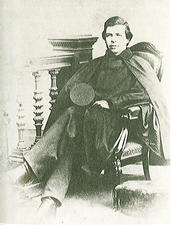Fred Wines Part 1
 One of the most prominent men in Springfield during the Civil War was Reverend Frederick H. Wines. Wines was born in Philadelphia, Pennsylvania on April 9, 1838. His father, Dr. Enoch Wines, was a college professor and well known philanthropist, a tradition later continued by his son. Young Frederick graduated from Washington and Jefferson College before enrolling at Princeton Theological Seminary. Before graduation, Wines became a missionary for the American Sunday School Mission. He arrived in Springfield on behalf of the organization and in December 1860, became pastor of Calvary Presbyterian Church. Because of his Union sympathies, Wines’ church was the only one in town not occupied by the army during the Civil War. He was also the only minister to hold regular services throughout the war.
One of the most prominent men in Springfield during the Civil War was Reverend Frederick H. Wines. Wines was born in Philadelphia, Pennsylvania on April 9, 1838. His father, Dr. Enoch Wines, was a college professor and well known philanthropist, a tradition later continued by his son. Young Frederick graduated from Washington and Jefferson College before enrolling at Princeton Theological Seminary. Before graduation, Wines became a missionary for the American Sunday School Mission. He arrived in Springfield on behalf of the organization and in December 1860, became pastor of Calvary Presbyterian Church. Because of his Union sympathies, Wines’ church was the only one in town not occupied by the army during the Civil War. He was also the only minister to hold regular services throughout the war.
Wines became the army chaplain at Springfield, an important position at a bustling post. Because of its location on the Telegraph Road and proximity to Arkansas, Springfield quickly became an important supply center for the Union army. It was also a major gathering place for refugees, especially Unionists from Arkansas. Caring for refugees was one of Wines’ primary duties. The needs of these civilians could be a drain on army resources and Union commanders often worked to ease the burden. Wines suggested the refugees could be put to work manufacturing clothing for military prisoners. According to Wines’ plan, initial funding would come from the army, but with time the enterprise could be profitable. Wines even thought this would help start a textile industry in Springfield after the war, but nothing came of his plans.
Chaplain Wines took an active part in the defense of Springfield on January 8, 1863. Confederate forces commanded by General John S. Marmaduke advanced into southwest Missouri from Arkansas, forcing the Federals to organize a hasty defense. Post commander General Egbert B. Brown gathered every available man to make a stand, including convalescents from the local hospital. Even Chaplain Wines appeared at Fort Number 4, (southeast corner of Elm and South Streets), firing a revolver and urging the soldiers to “Put your trust in Jesus, boys, and aim low!”
Wines returned to Princeton in the winter of 1864 and finished his course work for the ministry. He retuned to Springfield briefly in 1865 before settling in another Springfield, this time in Illinois. On October 29, 1865 he became pastor of the First Presbyterian Church there. Wines served the church for four years until he was appointed Secretary of the State Board of Charities. Wines never returned to the pulpit but instead dedicated his life to charitable works. He was a tireless advocate for the disadvantaged and wrote extensively on a variety of social issues including prison and asylum reform. Two of his best known publications are The Liquor Problem in its Legislative Aspects and The County Jail System: An Argument and Appeal for its Abolition. In addition to his charitable work, Wines served as the assistant director of the 1900 census. This job required Wines to live in Washington, D.C., for several years. After leaving the nation’s capital, Wines settled in Montclair, New Jersey, where he resumed his charitable work.
Reverend Wines died suddenly of neuralgia of the heart on January 31, 1912 in Springfield, Illinois. He is buried in Oak Ridge Cemetery in Springfield. In the next blog, learn about Wines’ significance to the Springfield-Greene County Library District.
Note: information for this article was taken from the Reverend Wines obituaries published in the Illinois State Register (Springfield), February 1 & 3, 1912 and from R.I. Holcombe, History of Greene County, page 452.
Find this article at http://thelibrary.org/blogs/article.cfm?aid=971&lid=62